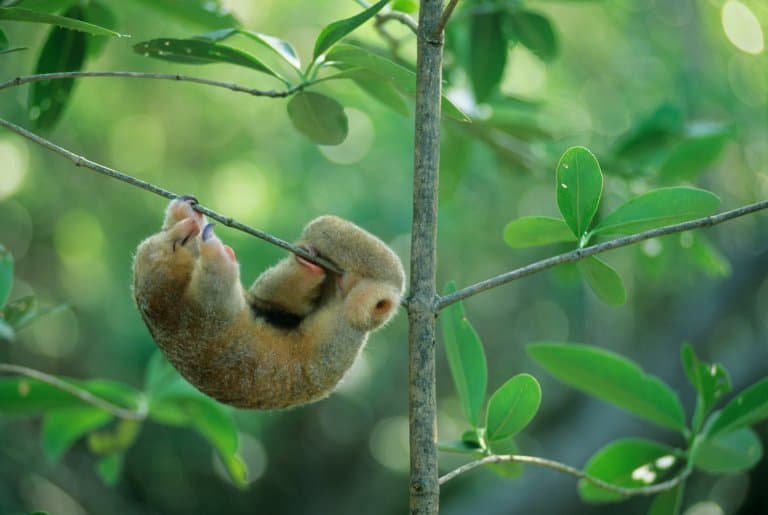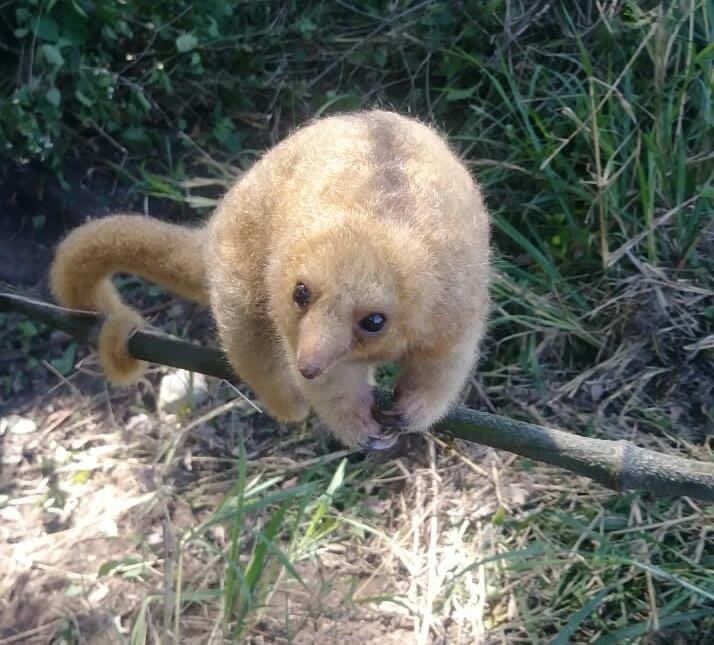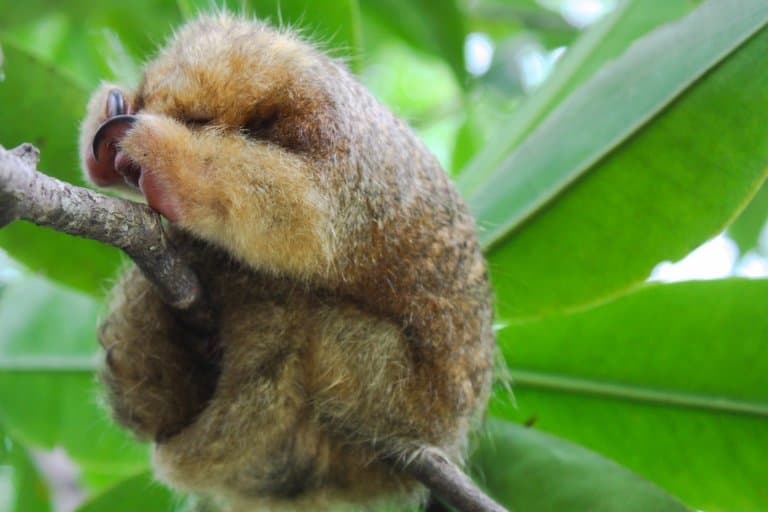Silky Anteater Profile
The smallest anteater in the world hangs out upside down in trees, high up in Central and South American forests. It’s the size of a squirrel, and remains more or less motionless all day, only moving at night.
This makes it hard to study, and so it remains relatively elusive, but new discoveries are shedding light on the urgency of its conservation.
The silky anteater is also known as the pygmy anteater, and while previously thought of as a single species, is actually several anteaters.

Silky Anteater Facts Overview
| Habitat: | Tropical forests above 1,500m |
| Location: | Central and South America |
| Lifespan: | 2 years |
| Size: | 55-70cm long, including tail |
| Weight: | 175 – 400g |
| Color: | Gray to yellow |
| Diet: | Ants |
| Predators: | Eagles, owls, |
| Top Speed: | Slow |
| No. of Species: |
Maybe 7+ |
| Conservation Status: |
Least Concern, based on outdated information (IUCN) |
They inhabit a range of rainforest types, from tropical, to mangrove to semi-deciduous where they can move from tree to tree in the canopy without descending.
This tiny, toothless insectivore is hard to pin down in more ways than one, yet appears to be a gentle, slow-moving, creature, averse to competition or over-exertion of any kind.
Their scientific name translates to “two-toed circle-foot”, which is in reference to their claws on their fore feet, which enable them to cling to branches.
Once thought to be a single species, new taxonomy shows a need for urgent reclassification and conservation assessment, as isolated populations are in decline due to habitat loss and fragmentation.
Interesting Silky Anteater Facts
1. They’re the smallest anteater in the world
Silky anteaters are the tiniest anteater species in the world, which is why there are often referred to as the pygmy anteater.
They are typically around 35-45cm in body length, with a tail around 15-25cm.
They can weigh as little as 200 grams!
2. They’ve got no teeth!
A silky anteater can cover some serious foraging ground in an evening. In the course of a single night’s forage, they can cross 38 trees and eat over 5,000 ants! They do this without being able to chew.
Not only are their jaws fused, but they’re also toothless. But since ants are small, they don’t need to be ground up. They are collected on a sticky tongue and swallowed whole.
Once inside the animal, there’s a muscular stomach, similar to a bird’s gizzard, that can grind and break down the ants. 1

3. They also have a taste for wasps
Silky anteaters also love to diet on wasps and wasp pupae.
They will sneakily attack a wasp nest in the middle of the night, when wasps are sluggish and more defenceless.
4. They’re not the only nocturnal, tree-dwelling anteater in town
Silky anteaters are arboreal, come out at night, and live in the same areas as their larger cousins the Tamanduas, who occupy a very similar niche.
But by way of avoiding competition, silkies and Tamanduas have partitioned the food supply. Silky anteaters eat only ants, leaving all the termites, beetles and insect larvae to the larger Tamandua.
So, while there’s significant overlap between the two species’ territories, they never need to waste energy arguing over who eats what!
5. They’re solitary creatures
Silky anteaters are typically solitary animals, that live alone but can live in close proximity within rainforests.
They come together to mate and will give birth to a single young up to twice each year. They are usually born on a nest of leaves in tree holes away from potential predators such as hawks, and harpy eagles.
6. They’re related to sloths
As members of the order Pilosa, silky anteaters share recent ancestry with more well-documented anteaters as well as the slow and upside-down sloth.
And like sloths, they have no opposable thumbs, which would be a handicap for a climber if it weren’t for the incredibly hooked forelimbs that help them in the trees.
These same claws that are so useful to their ground-dwelling relatives for opening ant hills have allowed these tiny anteaters to exploit the relatively untapped resource of arboreal ants.
A prehensile tail is another neat climbing aid, and in silky anteaters, it’s a long one! Their tails can be longer than their bodies and easily grip branches, acting as a fifth limb.

7. They have low metabolic rates
Silky anteaters share other interesting characteristics with sloths. They have a low body temperature and slow metabolism and can save much-needed energy in this way.
Ants in their habitats make up almost half of the insect biomass in the tree canopies, but even so, they don’t provide a great energy source, so every little bit needs to be conserved.
Silky anteaters regularly go into a state of torpor: a little hibernation when inactive so as not to use up any extra resources.
There is an opportunity cost here, though. These adaptations make the silky anteater a bit crap at regulating its own temperature, which means it is prone to overheating if it comes down to altitudes below 1,500 meters.
This is one of the limiting factors in the distribution of silky anteaters and has implications for its conservation.
Another issue that’s recently arisen comes from a new understanding of its taxonomy. 2
8. There are more species than we thought
As taxonomic classification systems become more accurate, things get more complicated, not less.
In the old days, we classified animals into groups based on how they look on the large scale, and this works well in many cases – a wood pigeon is clearly a different species than a common ostrich – but it misses a lot of smaller differences; differences in the molecular biology of species that look very similar.
Just a few years ago, in 2017, mischievous taxonomic researchers looked into museum collections of 287 silky anteaters and assessed their large-scale differences and their molecular ones, too.
They found that what was originally thought to be one species, Cyclopes didactylus, comprised at least seven species. Likely, there is more yet to be discovered. 3
9. This isn’t just pedantry
It can be tempting to disregard taxonomy as arbitrary labelling, performed by narcissistic researchers who don’t like to get their hands dirty, but still want the glory of putting their names on a new species.
While this does happen, it’s become much less prevalent since naming bodies move to restrict such practices and the scientific community increasingly thinks you’re a jerk if you do it.
But the major perks of taxonomy come from understanding how the biological world works, and perhaps most importantly, how each species fits into its ecosystem. This gets us much closer to learning how to conserve these species and their ecosystems.
For example, with this new information on species of silky anteater, it’s suggested that a population of Silkies in the Atlantic Forest in Brazil might be considered an “evolutionarily significant unit” (in this case, a species) and thus entitled to new and more concentrated efforts to conserve it.
This drives funding for forest restoration campaigns and other programs that simply wouldn’t exist for this species otherwise.
Currently, the last review for these animals by the IUCN comes before the discovery that they weren’t one species, which makes it very a pressing issue of urgent reassessment.
10. Habitat loss
Sugar cane production in the Atlantic Forest is one of the perpetrators of destruction for this population, but it doesn’t stop there.
The devastation of the Amazon rainforest threatens what may be isolated species of silky anteater all over the continent.
As a genus that’s limited to a small local range by its temperature and altitude requirements, habitat fragmentation can mean that genetic diversity is stunted and may become unviable. 4

Silky Anteater Fact-File Summary
Scientific Classification
| Kingdom: | Animalia |
| Phylum: | Chordata |
| Class: | Mammalia |
| Order: | Pilosa |
| Family: | Cyclopedidae |
| Genus: | Cyclopes |
| Species: | Cyclopes Didactylus |
Fact Sources & References
- Virginia Hayssen (2012), “Cyclopes didactylus (Pilosa: Cyclopedidae)”, American Society of Mammalogists.
- Flávia Miranda (2009), “Food Habits of Wild Silky Anteaters (Cyclopes didactylus) of São Luis do Maranhão, Brazil”, Bio One Digital Library.
- FLÁVIA R. MIRANDA (2017), “Taxonomic review of the genus Cyclopes Gray, 1821 (Xenarthra: Pilosa), with the revalidation and description of new species”, Zoological Journal of the Linnean Society.
- Virginia Hayssen (2012), “Cyclopes didactylus (Pilosa: Cyclopedidae)”, Oxford Academic.
